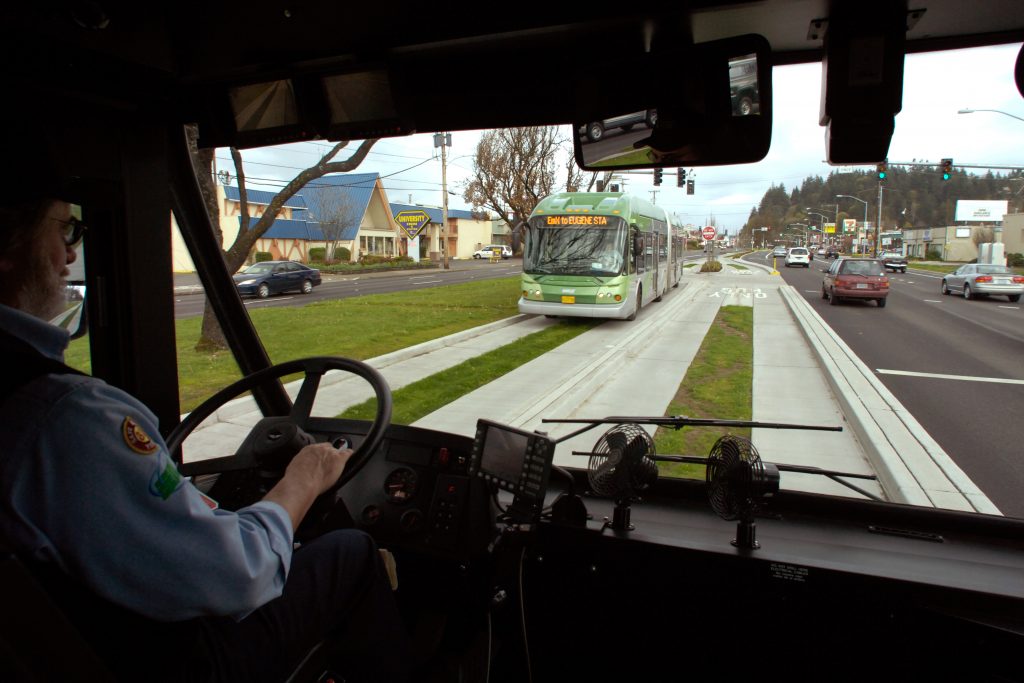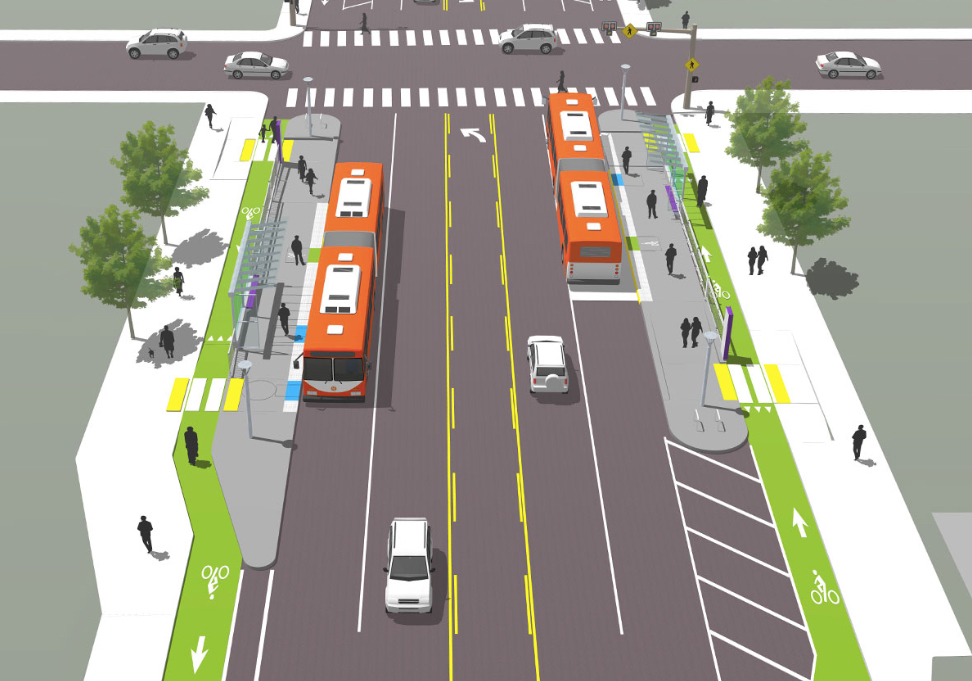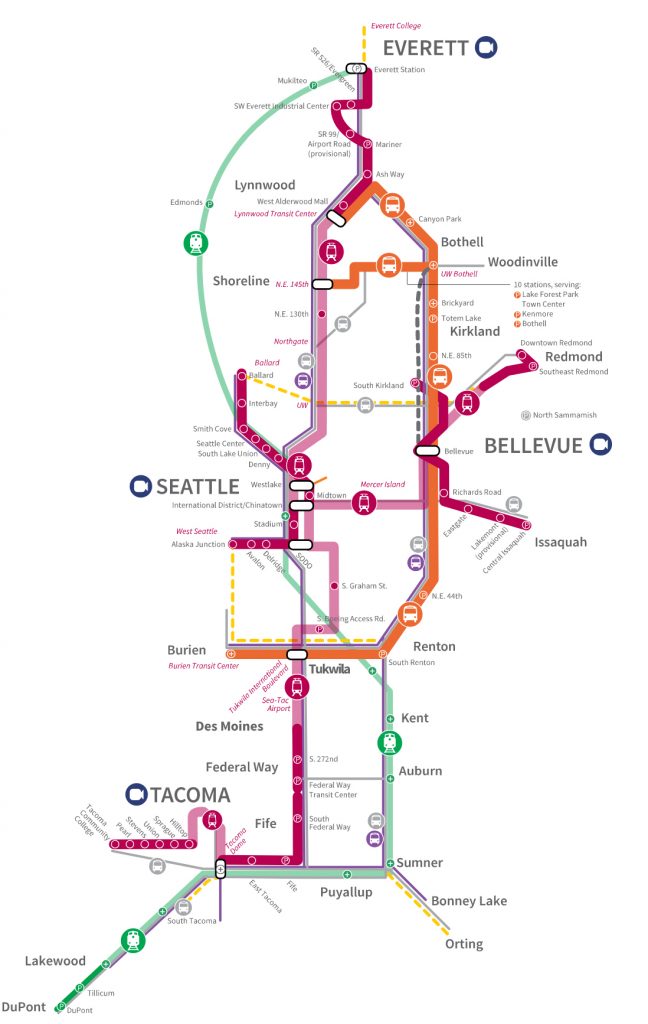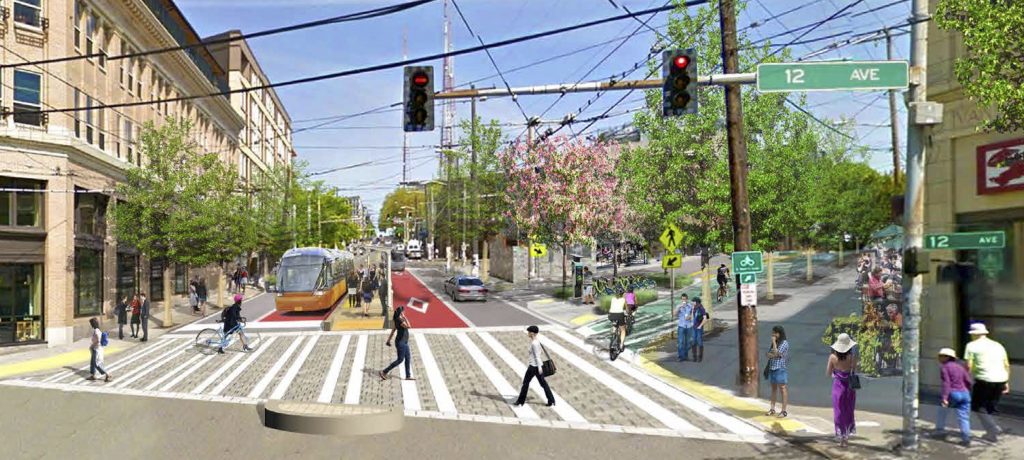Transit projects threatened in the Pacific Northwest by cuts to the federal New Starts program
Various planned bus rapid transit and light rail projects in Oregon and Washington would be eliminated if Congress heeds President Trump’s budget request to entirely eliminate the federal funding for new transit construction projects, profoundly impacting these communities’ futures.
Whether planned to accommodate new growth, attract talent, provide alternatives to soul-crushing congestion or access to jobs, these projects are essential to the vitality of these communities. Here’s a rundown of the transit projects in the Pacific Northwest that would be affected.
Spokane’s Central City Line
Spokane is a mid-sized city of over 200,000. Although it boasts seven college campuses, many students choose to move elsewhere after graduation, draining the city’s potential talent pool. Spokane understands the new paradigm: College graduates want to live in vibrant places with transit options, and attracting that talent is critical for economic success.
Part of Spokane’s plan to stem the emigration of talent includes building the Central City Line (CCL), an all-electric bus rapid transit line from Brown’s Addition through downtown to the University District. The project improves connections across the bus system and provides a better option to cross downtown. The region passed a ballot measure in November 2016 to cover operations costs for the CCL. But for the project to proceed with construction, it will need to win a federal Small Starts transit grant of $53.43 million to complete the $72 million project. Spokane’s ability to attract and retain a talented workforce and build its competitive edge hangs in the balance.
Eugene’s EmX Network

Expanding upon the Eugene-Springfield region’s successful EmX bus rapid transit network is key to their plans to accommodate growth without having to sprawl onto some of the world’s best farmland. The region already has two EmX bus rapid transit lines with a third under construction and several more lines planned. Lane Transit District (LTD) was awarded $131 million in Small Starts grants to build its first three lines. The agency won’t be able to proceed with lines in northwest Eugene, or on East Main Street in Springfield without continued federal support to augment their local contributions.
“With the fact that this area is growing so rapidly, there’s going to be a need and a want from the community to expand our transportation network,” said LTD spokesperson Theresa Lang in a recent article in the Eugene Register Guard. “If this budget goes into effect, that would be devastating for those future plans.”
Greater Portland’s Southwest Corridor and Division Transit Project
Greater Portland has plans to go big and small using transit to help accommodate more people in its fast-growing region. The big plan is the SW Corridor, a proposed light rail line from Portland to Tigard and Tualatin through Southwest Portland paralleling the frequently congested I-5 corridor. The planning for this corridor integrates land use and active transportation, but light rail is central. Currently in environmental review, the project’s sponsors are counting on receiving a full funding grant agreement (FFGA) in 2021 to begin construction and be completed in 2025.
“From a city standpoint, it has to do with traffic congestion and housing density,” says Tigard Mayor John Cook. “Without light rail, things will happen but it will take 50 years instead of 25 years.” With about a half-million more people expected in the region by 2040, they don’t have 50 years.
On the east side of Portland, planners endeavor to make a faster, less expensive investment. The Division Transit Project is a 14-mile express bus that will enhance speed, reliability and capacity on Portland’s busiest bus line from downtown Portland to Gresham through the most diverse neighborhoods in Oregon.

This smaller project is now eligible to apply for the $100 million Small Starts grant it needs in 2018 to open in 2021. The new line will reduce travel times by up to 20 percent and add articulated buses to address crush-load conditions that often force drivers to pass waiting riders with today’s inadequate service.
“Residents and businesses have been clear with us: Keep investing in transit,” says Metro Councilor Bob Stacey. “It’s critical, particularly as Portland grows and we all need more options to get places reliably and safely.”
Local access to jobs and a regional vision in Puget Sound
 The Puget Sound region’s transit ambitions are supported by ballot measures passed by voters in the City of Seattle and Snohomish County in 2015, and in the entire region when voters passed Sound Transit 3 (ST3) in 2016. The local measures fund plans for a seven-line BRT network in Seattle and additional BRT lines in Snohomish County. Expansion of Sound Transit’s regional Link light rail network and freeway-running BRT are major components of the regional plan funded by ST3. While local voters have committed billions of their own dollars to these projects over the next few decades, these plans all rely on federal support to varying degrees.
The Puget Sound region’s transit ambitions are supported by ballot measures passed by voters in the City of Seattle and Snohomish County in 2015, and in the entire region when voters passed Sound Transit 3 (ST3) in 2016. The local measures fund plans for a seven-line BRT network in Seattle and additional BRT lines in Snohomish County. Expansion of Sound Transit’s regional Link light rail network and freeway-running BRT are major components of the regional plan funded by ST3. While local voters have committed billions of their own dollars to these projects over the next few decades, these plans all rely on federal support to varying degrees.
Community Transit’s Swift Green Line from Bothell to Paine Field connects a great portion of Snohomish County with the massive employment center at Paine Field, where much of Boeing’s operations are based. . In the meantime Community Transit is proceeding to construction based on a “Letter of No Prejudice” (LONP) from FTA. That LONP is not a guarantee of federal funds but allows the agency to seek reimbursement once funds are committed through the single-year grant agreement. The agency is planning several other bus rapid transit lines in the future including the Swift Orange Line connecting with light rail when it reaches Lynnwood in 2023. Along with nearly all other similar transit projects, those projects will depend on future federal transit construction grants.
Move Seattle passed in the core city of the region in 2015, and provides much of the funding for seven BRT lines crisscrossing Seattle. Madison Street BRT (also called the RapidRide G line) is already in planning. The $120 million project was originally planned with the expectation of a $60 million Small Starts grant. Without federal funding, the fate of the project, which would enhance access to the dense downtown Seattle core, may have to be delayed from its 2019 completion date. This pushes back construction of the other six BRT lines in this fast-growing city with major traffic congestion; lines that Seattleites already committed to paying their share for.

The amount of federal funding sought for the full 25-year Sound Transit 3 plan is small in proportion to the amount locals voted to pay in local taxes and fees — just $4.7 billion in New Starts funding vs. $54 billion total cost. But without federal support the plan cannot be completed within the 25-year timeframe, leaving communities on the edge of the region like Issaquah without the light rail connections they were promised.
Puget Sound residents have stepped up and voted to tax themselves to build these systems with the expectation they’d be joined by a reliable federal funding partner.
“The ballot measures adopted by our voters assumed a reasonable level of federal matching funds to deliver our most challenging transit solutions through the continued funding of the Federal Transit Administration’s Capital Investment Grant program,” said Sound Transit CEO Peter Rogoff in a joint statement with the LA Metro CEO. “But the administration’s budget proposes to terminate that federal partnership for challenging projects at a time when ever-worsening road congestion threatens to choke off our and other regions’ economic growth.”
If the federal government disregards its historical role and commitment as a funding partner on transit projects, it will absolutely hamper this economic powerhouse’s job growth, harming the national economy in turn.
With so many critical projects on the chopping block if the relatively small federal transit capital program is eliminated, it’s no wonder that many in the Pacific Northwest are eager to weigh in with the administration and Congress as they choose what to do with this vital program in the 2018 budget that is due to begin in October.




















Pingback: Portland Launches Public Adaptive Bike Rental for People With Disabilities – Streetsblog USA